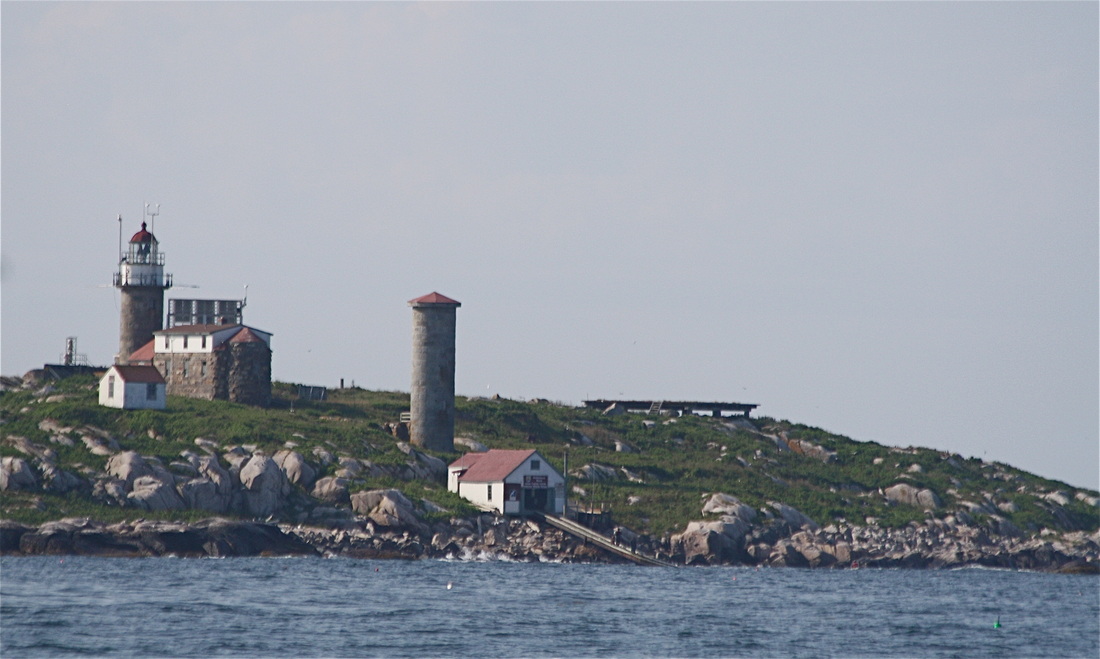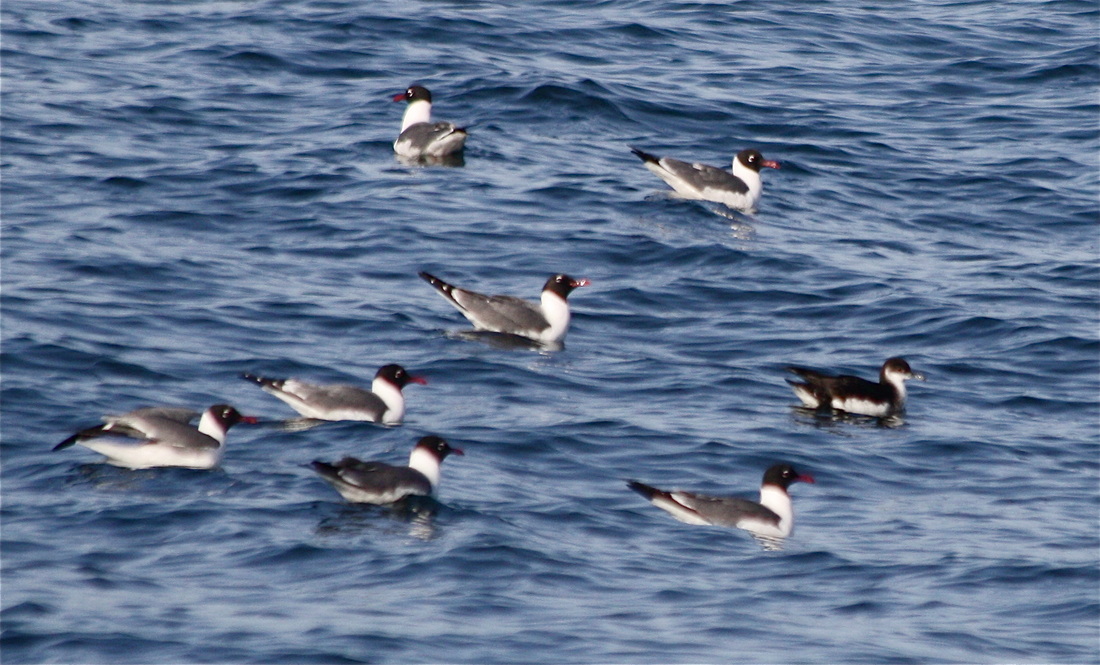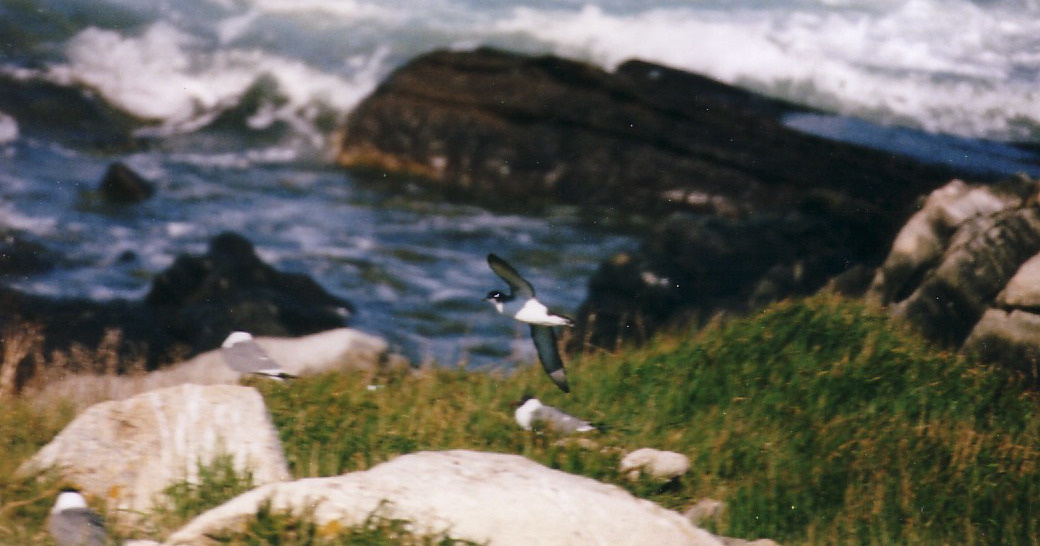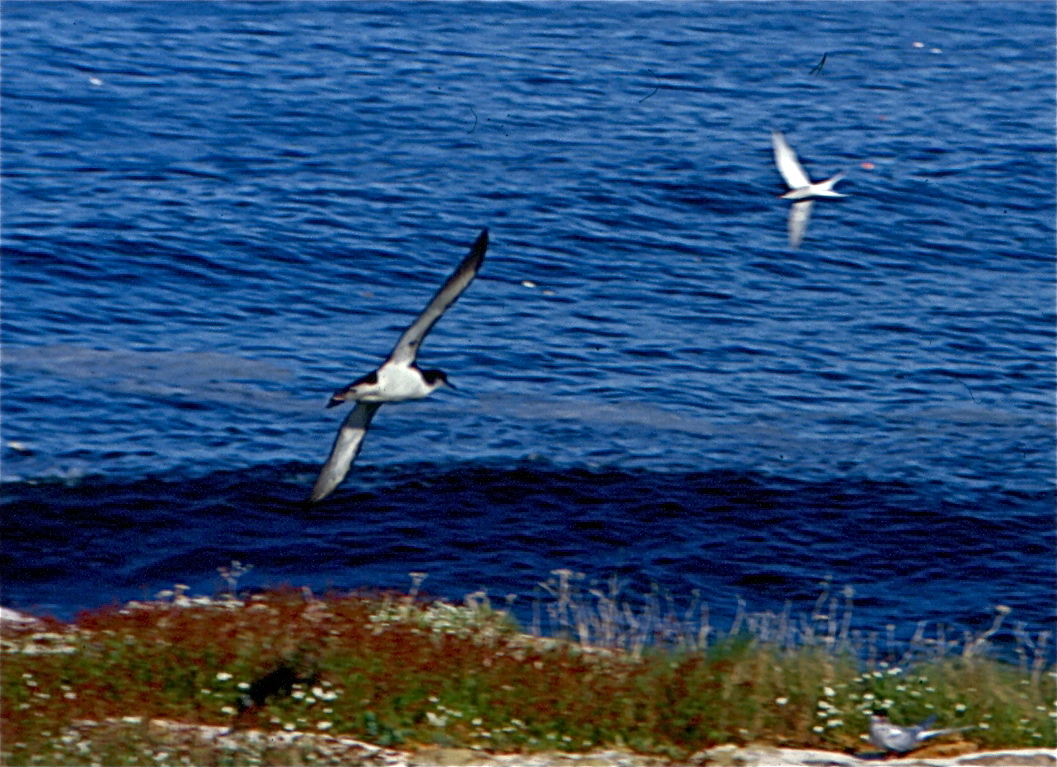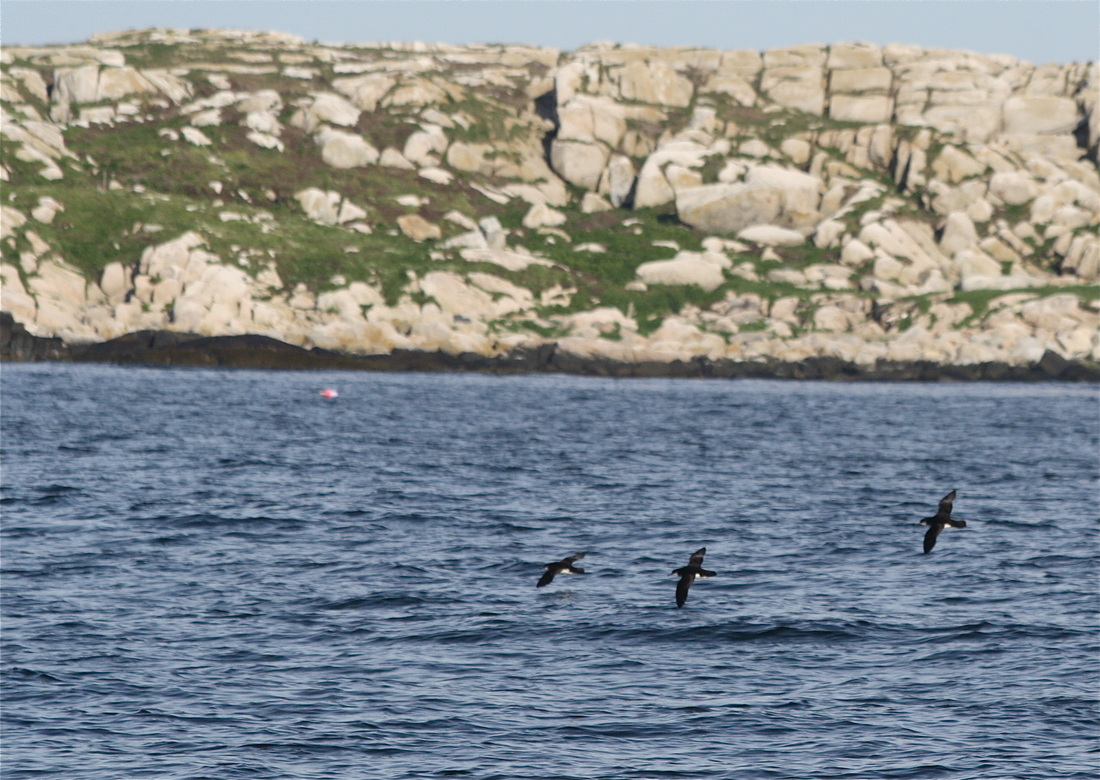MANX SHEARWATER, THE UNEXPECTED ARRIVAL OF AN ELEGANT NEIGHBOR
I wrote this a few years ago it was published in the free press,
Clearly an individual of non traditional inclination, a Manx shearwater has in recent years bonded with a seabird colony in the gulf of Maine 800 miles from what was the species only known North American nesting site. First seen during late May of ’97 this bird is a pioneer behaviorally as well as geographically performing display flights over its chosen burrow site during the daytime for eight seasons, (behavior previously unknown in this well studied species) and it hangs out with laughing gulls. Apparently male, having dug a burrow, this birds commitment to the island has apparently attracted other Manx to the area, the number of individual Manx attending the Island during late May these last dozen years has increased steadily. I have been fortunate enough to be able to spend several days on the island during late May all but one of those years observing the Manxs’ and helping open the station. We were quiet enthused seeing 4 individuals May 20, 2000. There were 10 manx, alternately sailing around together and roosting on the water SW of the Island just before sunset May 24 of ‘07, There was a high count of 16 in ‘010.
Matinicus Rock,
Recently there have been about a thousand pairs of terns nesting on the island and several hundred pairs of laughing gulls as well as Guillemots, Puffins and Razorbills. The terns show up around the middle of May after going to South America, common terns, or flying all over the Atlantic Ocean, Arctic terns. It takes a while for the terns to settle in, eggs appear near the end of the month, poor weather or a Peregrine falcon foraging at the island can delay the terns settling, anyway, during those days before eggs, the terns will come in bands swelling to noisy hundreds at dawn, sail around and maybe land on their nest sites to reestablish their pair bond and reclaim their small piece of turf. By late morning most of these birds have sailed off and the island is quiet. The laughing gulls guillemots and puffins, emboldened by the presence of the aggressive terns, come ashore while the terns are around the island and move back to the water or away to feed after the terns leave the area. It was only when the laughing gulls were ashore that the manx performed its display flights over the island. When the terns leave the island the laughing gulls move off to loaf on the water in bunches off the South Western shore, then the manx is easy to find as it is usually loafing in a raft of laughing gulls. It has given up on the daytime displays these last few years but still roosts with the laughing gulls on the water as at times do some of the other Manx that have been infected with enthusiasm for the site.
Manx roosting near the island with a raft of laughing gulls
This is the kind of individual who could found a new population, a new race, maybe given time a new species. It makes me wonder what relevance behavior might have in effectively isolating a group of individuals, within a population, who take advantage of a different resource.
How is it that this individual came to bond with this site and apparently develop an attraction to another species?
Well there was a manx that crashed into the cb antennae on eastern egg Rock in ’95, Kristen Williamson was there. She heard the impact and found the bird flopping in the long grass. Not all right the Bird was boxed for the night and released in the morning, turning on the roof of the shack there to get its bearings and sailing off apparently ok. Eastern egg rock is home to a large laughing gull colony and they make quite a racquet. Perhaps this was the manx, maybe a young bird, who, having suffered head trauma and exposed to the cackling of laughing gulls all night, became imprinted on them and looked or maybe listened for them in subsequent seasons. During the late nineties there were some sightings of manx displaying odd daytime behavior at Petit Manan and Eastern Egg Rock, the other two laughing gull colonies in the area. There have not been such reports at these other sites during more recent seasons as this individual has apparently become more bonded with the particular colony at Matinicus Rock.
How is it that this individual came to bond with this site and apparently develop an attraction to another species?
Well there was a manx that crashed into the cb antennae on eastern egg Rock in ’95, Kristen Williamson was there. She heard the impact and found the bird flopping in the long grass. Not all right the Bird was boxed for the night and released in the morning, turning on the roof of the shack there to get its bearings and sailing off apparently ok. Eastern egg rock is home to a large laughing gull colony and they make quite a racquet. Perhaps this was the manx, maybe a young bird, who, having suffered head trauma and exposed to the cackling of laughing gulls all night, became imprinted on them and looked or maybe listened for them in subsequent seasons. During the late nineties there were some sightings of manx displaying odd daytime behavior at Petit Manan and Eastern Egg Rock, the other two laughing gull colonies in the area. There have not been such reports at these other sites during more recent seasons as this individual has apparently become more bonded with the particular colony at Matinicus Rock.
the Manx Sweeping over island, over the area that laughing gulls were concentrated.
It is estimated that 83% of all Manx shearwaters nest on islands off Britain and Ireland, of those 36% nest on the Isle of Rhum Scotland and 45% nest on three islands off Wales.
There has been a small colony of Manx shearwaters on an island off the southern coast of Newfoundland discovered about 1980 (The colony not the island). Several hundred birds are associated with this colony yet there were less than 10 burrows found judged to be active at this site in 2002.
During the last 60 years Manx shearwaters sightings in the western Atlantic have increased steadily. There is no known archeological evidence of a Manx population in North America. These birds are apparently moving into an area not occupied by their species since before the last glacial period.
These last few years we have seen 8 or 10 manx sailing around together just around sunset, off to the SW of the island, apparently bonding with each other and the site, like a team of Russian pair skaters but more elegant. At least one chick has been produced at Matinicus rock these last 2 years, the first known Manx raised in the US.
There has been a small colony of Manx shearwaters on an island off the southern coast of Newfoundland discovered about 1980 (The colony not the island). Several hundred birds are associated with this colony yet there were less than 10 burrows found judged to be active at this site in 2002.
During the last 60 years Manx shearwaters sightings in the western Atlantic have increased steadily. There is no known archeological evidence of a Manx population in North America. These birds are apparently moving into an area not occupied by their species since before the last glacial period.
These last few years we have seen 8 or 10 manx sailing around together just around sunset, off to the SW of the island, apparently bonding with each other and the site, like a team of Russian pair skaters but more elegant. At least one chick has been produced at Matinicus rock these last 2 years, the first known Manx raised in the US.
Manx group bonding with site, by sailing around together near the island
